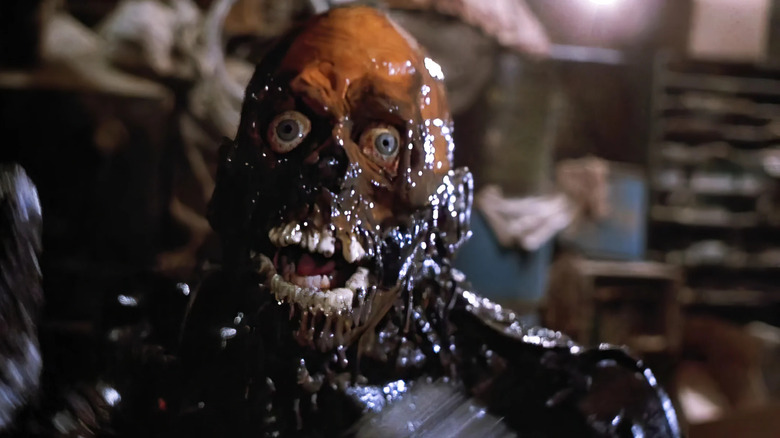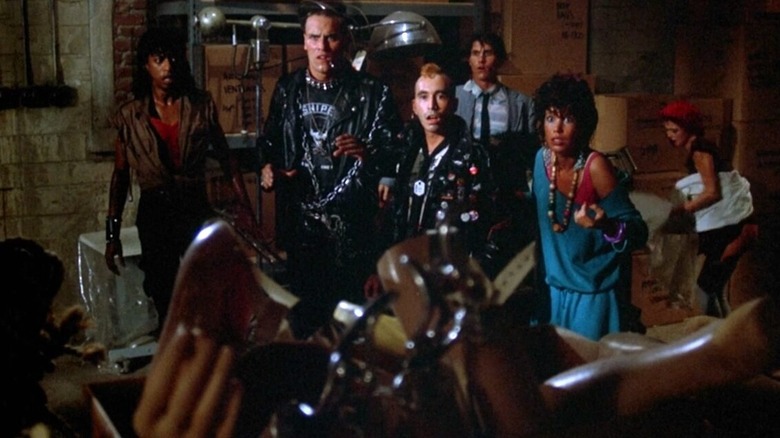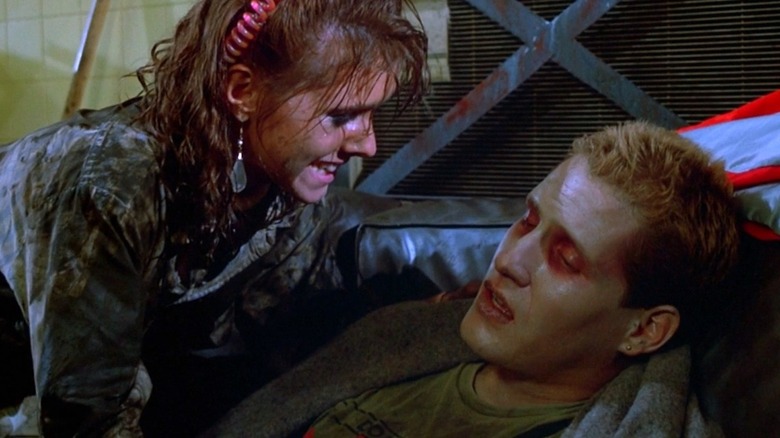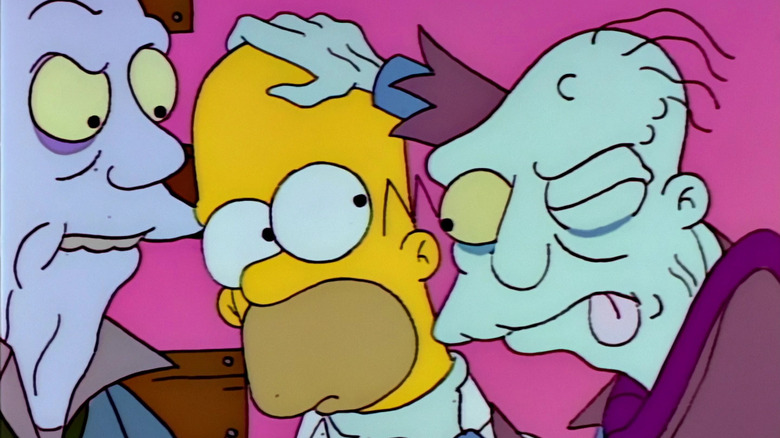This Cult '80s Horror Put Brains On The Menu For Zombie Flicks
Being a zombie must be hungry work. First of all, you're on your feet all day and night. Have you ever seen a zombie taking a seat or laying down for a nice little nap? You'd be ravenous just from the effort of constantly roaming around and fighting with other members of the horde for the next morsel of human flesh. It certainly doesn't help matters that victims who aren't finished off properly have a nasty habit of getting back up and competing with you for your next meal. You need to stack up on the calories if you are going to stay ahead of the competition as you lurch across the post-apocalyptic landscape in shambling pursuit of the ever-diminishing supply of fresh flesh.
Zombies going to town on a victim is always one of the queasy highlights of any modern zombie movie. You just know there is one character who will end up getting swarmed and pulled apart, followed by the grisly spectacle of the undead chowing down on arms, legs, guts, and cracking open the skull to get at that greatest of all zombie delicacies, the human brain.
But hold on a minute there. Believe it or not, for the first half century or more of onscreen zombies, the undead didn't eat grey matter at all. The godfather of the modern zombie movie, George A. Romero, didn't show it in his landmark movies that began with "Night of the Living Dead," and even goremeisters like Lucio Fulci ("Zombi 2") never thought to do it. It wasn't until the 1980s that we finally got to see a little brain-noshing action, with a flourish. While previous zombies were usually mute other than moaning and groaning, these guys liked to shout about it: "BRAINS!!!" The film was Dan O'Bannon's bleak horror comedy "The Return of the Living Dead."
So what happens in The Return of the Living Dead again?
Frank (James Karen), the manager of a medical supply warehouse, is trying to impress his new employee Freddy (Thom Matthews) with all the ghoulish stuff they've got in stock. There are skeletons, split dogs for veterinarian schools, a cadaver hanging in the meat locker, and a corpse sealed up in a military drum of toxic gas in the basement. When Frank accidentally ruptures the drum, spraying them both with gas, the leak brings all the dead things back to life.
After Frank and Freddy are attacked by the reanimated cadaver, they discover that the usual methods of incapacitating a zombie don't work. Their boss asks his friend at the local mortuary to incinerate the dismembered parts. This only releases particles into the air, which gets caught up in a rainstorm and contaminates the cemetery across the street, where Freddy's punk friends are partying until he finishes work.
The formerly restful dead claw their way out of their graves as indestructible zombies with a penchant for human brains. As the situation escalates, the survivors barricade themselves inside a funeral home. Meanwhile, military bigwigs are making a grave decision to contain the outbreak.
Any modern zombie movie is inherently doom-laden, with the 21st century resurgence of the genre commonly interpreted as existential anxiety after the events of 9/11. "The Return of the Living Dead" is especially hopeless, with a version of the undead that are impossible to kill and a U.S. military willing to nuke a whole town to curb the crisis, only to make it worse.
Yet until "Shaun of the Dead," almost 30 years later, zombie apocalypses were rarely this funny. "The Return of the Living Dead" provides far more laughs than scares, and pitting a gang of nihilistic punk rebels against indestructible zombies was an inspired match. It's a one-off in the genre, closer in attitude to "Repo Man" than any other zombie movie, highlighted by its incredible punk rock soundtrack. Is there a better tune for the ubiquitous scene of zombies busting through the barricades than the deliriously deadpan psychobilly track, "Surfin' Dead?"
How The Return of the Dead reimagined zombies
Before George A. Romero's "Night of the Living Dead," zombies didn't eat much at all. They were an entirely different beast, usually victims turned into somnambulistic slaves by voodoo magic, as in Jacques Tourneur's eerie "I Walked With a Zombie," often just wandering around doing their master's bidding.
Romero changed all that. In his landmark low-budget shocker, zombies became cannibalistic, driven by a primal urge to feast upon the living. The showstopper was a bunch of zombies sloppily munching on some spilled intestines. Notably, Romero's film never uses the word "zombie," and he originally took his inspiration from Richard Matheson's "I Am Legend" (via The Guardian) rather than the old voodoo-style zombies.
Romero's stark exercise in undead terror was the first modern zombie movie, but it wasn't until his co-writer John Russo teamed up with Dan O'Bannon on "The Return of the Living Dead" that brains became the food of choice for shamblers.
Why did their zombies hunger for grey matter? The survivors manage to capture one and ask her why. She tells them that she craves brains to ease the pain of being dead, because she can feel herself rotting. Author and minister Jack Flacco speculates (via Looking to God):
"Brains provide zombies with the necessary endorphins to dull the pain of Rigor Mortis brought about by decomposition. The more brains, the less pain. In some ways, zombies get a high consuming the delicacy. And with that idea in mind, is it a wonder no one thought of it sooner?"
O'Bannon's movie also tweaked several other key aspects of modern zombie lore. In Romero's original vision, death itself triggers the change into zombies, while "Return" popularized the notion that it is zombie bites or fluids that pass on the contagion. O'Bannon's zombies also couldn't be killed by a classic headshot; they just keep on coming no matter what you do. Peter Jackson's "Braindead" ran with this notion, where even zombie guts can still chase after you.
Other changes were fast zombies, which really took off with "28 Days Later," "World War Z," and many others. There have also occasionally been smarter zombies than previous incarnations of the movie monsters. Romero experimented with the idea of undead that could learn, notably in "Day of the Dead," with a friendly domesticated zombie named Bub. Zack Snyder, among others, adopted this concept, but the fact is that smart zombies just aren't as scary as mindless ones. In "Return" their cleverness is played for laughs, like when they ambush a police car, have a munch, then radio for backup, "Send more cops."
The enduring myth of brain-eating zombies
All of O'Bannon's contributions to the modern zombie have taken off in some degree — quickness, indestructibility, smartness, and infectiousness — but it is the brain eating that the film is best remembered for. Yet beyond "Return," there aren't many examples of zombies crying, "Brains!" as they hunt down their favorite snack. So how has this trope and Halloween-night catchphrase developed beyond this cult horror comedy from the 1980s?
Some speculate that the brain-eating myth wasn't popularized by "The Return of the Living Dead" at all, but something far more family-friendly: "The Simpsons." In 1992, the show aired its third instalment of its popular "Treehouse of Horror" anthologies. In the segment "Dial Z for Zombies," Bart accidentally raises the dead when he tries to resurrect Lisa's beloved cat with an occult spell. The book that contains the spell has a concise summary:
"Chapter 8: Let's Talk Zombies. If a zombie bites you, you become a zombie. You must walk the earth feeding on the brains of the living until the spell is broken."
On cue, Bart's inadvertent zombie army groan, "Brains!" as they shamble around town, with undead Principle Skinner craving school swot Martin's "big juicy chess club brain." As Matthew Belinkie of Overthinking It reasons:
"I'm guessing that many more people saw this Simpsons episode than O'Bannon's movie. It's certainly beloved by fans – IGN picked "Dial Z for Zombie" as the second-best Treehouse of Horror segment ever. But more importantly, millions of kids saw this episode before they were old enough to see a real zombie film. I suspect that for a whole generation, this was the first zombie story we ever saw. And that, my friends, is why we think that zombies eat brains, even though most of us have never seen a movie where this is the case."
He could be right. While "The Return of the Living Dead" originated the concept, it may well have been the people of Springfield that spread the contagious idea that zombies love eating brains.



